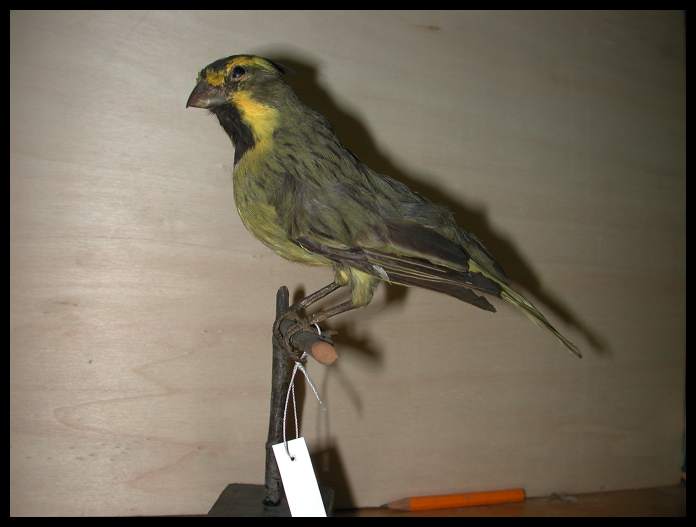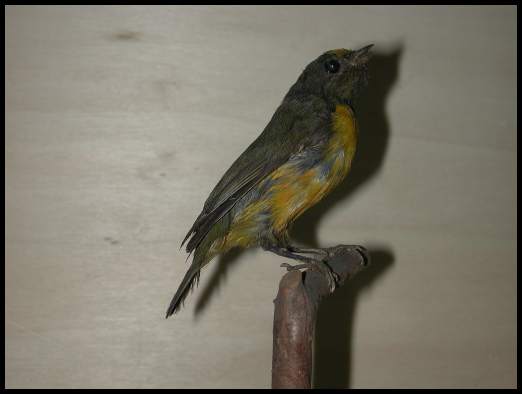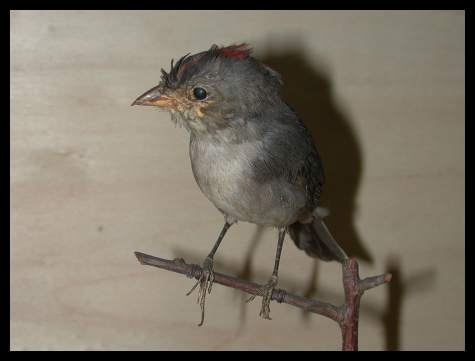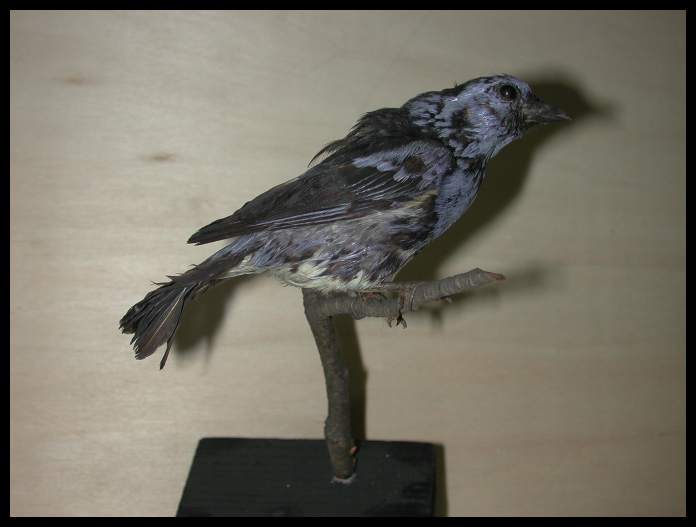When you're dealing with a snapshot of the avifauna of the nineteenth century you're sure to get to observe some drastic changes when compared with the present day. As soon as I saw this character gazing glumly from the serried ranks in the storeroom I knew it had to be something special... if it weren't then every cagebird fanatic would want one:

A huge bird, about the size of a large male Corn Bunting (Milaria calandra) it's a "Yellow Cardinal (Gubernatrix cristata) - a species of bird in the Thraupidae family. Sometimes classified in the bunting and American sparrow family Emberizidae, more recent studies have shown it to belong with the tanagers. It is the only member of its genus, Gubernatrix, (which if my memory serves me right means 'Governess' in Latin).
"It is found in Argentina, Brazil, Paraguay, and Uruguay. Its natural habitats are dry savanna, temperate shrubland, subtropical or tropical moist shrubland, and temperate grassland. It is threatened by habitat loss." Birdlife International reckons there are only 1,500 - 3,000 Yellow Cardinals left in the wild and the species is classified as 'Endangered'. It must have been a lot commoner 140 years ago, roughly when this specimen was collected.
Several more interesting birds over the last couple day of days including a Sharp-tailed Streamcreeper (Lochmias nematura), several Shiny Cowbirds (Molothrus bonariensis), assorted Whydahs and Widow-birds and a juvenile White-winged Cliff-chat (Myrmecocichla semirufa) which the label correctly said had originated in Abyssinia!
Three more from the store:
...a grotty little Euphonia with a broken beak:

Blue-naped Chlorophonia (Chlorophonia cyanea)
... some sort of fire-crested junco-tanager thingy:

Pileated Finch (Coryphospingus pileatus)
... and the last is a tanager true and proper:

Turquoise Tanager (Tangara mexicana)
I'm really grateful for all the help so far. More moth-eaten mystery from the vaults tomorrow!

A huge bird, about the size of a large male Corn Bunting (Milaria calandra) it's a "Yellow Cardinal (Gubernatrix cristata) - a species of bird in the Thraupidae family. Sometimes classified in the bunting and American sparrow family Emberizidae, more recent studies have shown it to belong with the tanagers. It is the only member of its genus, Gubernatrix, (which if my memory serves me right means 'Governess' in Latin).
"It is found in Argentina, Brazil, Paraguay, and Uruguay. Its natural habitats are dry savanna, temperate shrubland, subtropical or tropical moist shrubland, and temperate grassland. It is threatened by habitat loss." Birdlife International reckons there are only 1,500 - 3,000 Yellow Cardinals left in the wild and the species is classified as 'Endangered'. It must have been a lot commoner 140 years ago, roughly when this specimen was collected.
Several more interesting birds over the last couple day of days including a Sharp-tailed Streamcreeper (Lochmias nematura), several Shiny Cowbirds (Molothrus bonariensis), assorted Whydahs and Widow-birds and a juvenile White-winged Cliff-chat (Myrmecocichla semirufa) which the label correctly said had originated in Abyssinia!
Three more from the store:
...a grotty little Euphonia with a broken beak:

Blue-naped Chlorophonia (Chlorophonia cyanea)
... some sort of fire-crested junco-tanager thingy:

Pileated Finch (Coryphospingus pileatus)
... and the last is a tanager true and proper:

Turquoise Tanager (Tangara mexicana)
I'm really grateful for all the help so far. More moth-eaten mystery from the vaults tomorrow!



